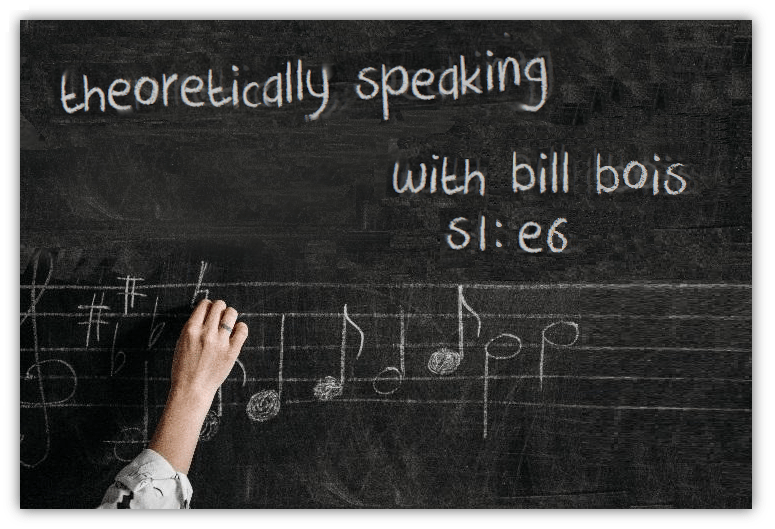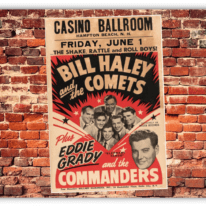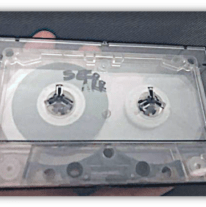Music Theory For Non-Musicians
…if there was ever an art where breaking the rules is one of the rules, it’s music.
redditor u/COMPRIMENS
This occasional series is about how music is made, and it’s for people who don’t already make music. It’s part music appreciation and part music theory.
I hope to cover rhythm, melody, intervals, chords, inversions, and more. Maybe we’ll get into extended chords and modes. Let’s see!
S1 : E6: I’ve Got The World On A String
Alright, alright, I can hear you all say, “OK, Theory Dude, these major and minor chords are all well and good, but they make my head hurt.”
“I just want to rock and roll.”
I hear you. And what we really need to rock and roll is:
a guitar.

So far I’ve only shown you notes and scales and chords using the piano keyboard. That’s because it works well in a static graphic on a web page, and I’m sure everyone reading this has at some time or another plinked some keys. The low notes are to the left, the high notes are to the right. It’s pretty easy to understand.
String instruments are a little less obvious. It’s harder to grasp exactly what’s going on. Sure, we already know that you press your finger on a string at a certain spot to get a certain note. And we know that the shorter you make the string the higher the note’s pitch is. But, how the heck do the strings relate to each other?
There’s not really an easy answer because each instrument has its own tuning, and each instrument can be tuned in multiple ways. So let’s start with the bass guitar. It’s simple and consistent and there’s only four strings. How hard can it be?
Or so I thought when I started playing.
I’ll put in a slight disclaimer here. Some people tune their basses differently. Some basses have five strings or six strings. There are all sorts of permutations outside today’s scope. This article is limited to the four string bass guitar, with frets, in standard tuning, played right handed (meaning using the right hand to pluck and the left hand to fret).
The first misconception to tackle is where the low string is. Some people think that means it’s lowest as in it’s closest to the floor. What “the low string” really means is that it plays the lowest pitch. It happens to be closest to the ceiling. It’s also closest to your eyes when you’re playing.

You’ll sometimes hear someone say to play a string “open,” and that’s just another way of saying to play the string without fretting a note. The low string on a bass is the E string, which means if you pluck it without fingering any note with your left hand, you’ll get an E. That’s the lowest pitch on a bass guitar.
If you press your finger on the first fret of the E string, you’ll get an F. This is just like on a keyboard. The next note up from an E is an F.
Here’s a keyboard layout for reference.

Fretting at the second fret produces an F# or Gb (it’s like a black key on the keyboard) and the third fret is a G. As you keep going, it’s all the same notes as the keyboard, so from the low E up to the 12th fret gives you all the notes. E, F, F# or Gb, G, G# or Ab, A, A# or Bb, B, C, C# or Db, D, D# or Eb, and E.
This diagram shows the notes on the E string up to the twelfth fret. The frets are numbered from 0 to 12, and the 0 means you play the string open.

The string next to the E string is the A string. Wait, what? Wasn’t there already an A on the E string?
Sure, at the fifth fret. The open A string is exactly the same note as the 5th fret of the E string. So if you’re playing that low E and the next note you need to play is an A, you have two choices. You can play either the 5th fret of the E string, or the open A string.
Just like a keyboard where the next note up from A is A# or Bb, the first fret on the A string is A# or Bb. The second fret is B, the third fret is C, the fourth fret is C# or Db, the fifth fret is D, and so on up the neck.
So if the 5th fret of the E string is an A, and the string next to it is the A string, and the 5th fret of the A string is a D, what do you suppose the next string is? That’s right, it’s the D string.
And on the D string, the first fret is, you guessed it, D# or Eb. The second fret is E, the third fret is F, the fourth fret is F# or Gb, the fifth fret is G, and so on up the neck. Based on that, what’s the next string?
Right, it’s the G string. I won’t list all the notes because you can see them on this basic diagram of the first twelve frets of all four strings. Diagrams like this almost always show the low string at the bottom. I think that’s because this it’s what you see when you’re leaning over the neck trying to put your fingers in the right places.

So what we see is that the fifth fret of each string is the same pitch as the next string. Why? What good does that do us?
Let’s say you need to play the C major scale. C, D, E, F, G, A, B, and C. On the keyboard, there’s only one way to do it (unless you want to change octaves). On the bass, there’s a C at the third fret of the A string and another at the eighth fret of the E string. That gives us two different starting points (unless you want to change octaves).
And if we use the starting point on the A string, there are two different ways to play the scale. The first is to use the open strings for a couple notes. You’d play the C on the A string, the open D string, the E and F on the D string, the open G string, and the A, B, and C on the G string. I’ll color code these notes in blue.

Picture your left thumb on the back of this imaginary bass neck. If you put your middle finger on the third fret of the A string, that’s the C. You can then remove your fingers altogether to play the open D string.
And because you used your middle finger on the third fret, your index finger is right over the second fret. Put it there on the D string and you’ve got the E. Your middle finger can then easily fret the F on the third fret.
Remove all your fingers again and pluck the open G. Then play the A with your index finger on the second fret, the B with your ring finger on the fourth fret, and the high C with your pinky at the fifth fret.
There! You’ve just played the C major scale. do re me fa so la ti do.
Now let’s do it without using open strings.

Like before, put your middle finger on the third fret of the A string to play C. Instead of using the open string for the D, use your pinky to play the fifth fret of the A string. Then just like before, play the E at the second fret of the D string with your index finger, and the F at the third fret with your middle finger.
Now, instead of playing the G using the open G string, play the G at the fifth fret of the D string with your pinky. Then as before, play the A with your index finger on the second fret of the G string, the B with your ring finger on the fourth fret, and the high C with your pinky at the fifth fret.
That’s two ways to play the C major scale starting at the same point. Interesting, right?
So what’s the benefit of using one or the other? Well, obviously open strings are easier. No wear and tear on the left hand. However, keep the second method in mind for a second while we look at the other starting point. Where was it? Oh yeah, eighth fret of the E string.
So put your imaginary middle finger on the eighth fret of the E string. That’s a C and the other starting point. Remember, just like the A at the fifth fret of the E string is the same note as the open A string, the C at the eighth fret of the E string is exactly the same note as the C at the third fret of the A string, as you can see below. Same note, two different places to play it. Take that, piano players!

Now put your pinky on the tenth fret of the E string and that’s your D, the “re” of do re me fa so la ti do.
Then put your index finger on the seventh fret of the A string for the E, your middle finger on the eighth fret for the F, and your pinky on the tenth fret for the G. And switch to the D string for the A on the seventh fret, the B on the ninth fret, and the octave of C on the tenth fret.
I’ve put the two methods of playing the C major scale without using open strings below, and color coded them. The blue notes use the starting note of the C at the third fret of the A string. The green notes use the starting note of the C at the eighth fret of the E string.

Notice that they’re the exact same pattern, just starting in different places. Cool, right? Now watch this.
Some of you are ahead of me here but let’s say it: If that pattern works in those two places, can it work in other places on the neck? Yes. Absolutely. That’s one of the things that makes string instruments (eventually) easy to grasp.
So if this is the C major scale starting at the third fret of the A string…

… and you slide it up one fret…

… what does that give you? Yes, it’s the C# or Db major scale! And if you slide it up another fret…

… you get the D major scale. The same pattern starting at points gives you different scales.
That’s the brilliance of string instruments. Once you learn the pattern, you can just move it all over the neck. There’s none of this memorizing whole steps and half steps nonsense. If you can play it in one key, you can play it in any key.
Genius.
I’m simplifying, of course, but that’s basically true. It’s one of the reasons kids start garage bands with guitars and basses and drums. Almost any song you learn can be easily transposed to other keys to match your singer’s voice.
Besides: pianos are expensive.
Let the author know that you liked their article with a “heart” upvote!






E=mc5 is genius.
I always happy to see what bits of brilliance mt58 adds. Genius indeed.
I serve at the pleasure of our writers and viewers.
Grazie, Chuck & V-Dog. Very kind.
(…frantically checking FB marketplace for a used bass guitar…)
You gotta. Really.
It’s a given I am nowhere in Bill-dog’s pro league, but I can make noise on a few different instruments. And I’m not sure why, but the bass might be the most “fun” of all.
When the phone rings and someone needs an emergency hack to clumsily fill in on the bass at the last minute, I am so there.
I don’t know what league mt58 thinks I’m in (even the bowling league seems skeptical) but I’ll suggest you walk into your closest music store. The big box stores like Guitar Center or Sam Ash will do, but don’t overlook the mom & pops and even the pawn shops in your area. They’ll all have used instruments that you can play before you buy. Cheap, too. There are even some decent new basses under $300 these days.
Rule of thumb, always ask before you take an instrument off the wall. It’s usually fine, but some stores prefer to take it off the wall and hand it to you.
Plunk out a few notes. What you’re looking for is a neck that feels good. Some people prefer thinner necks, some prefer thicker. As a total beginner, you may not know the difference, but play a few until you find one that feels right.
When in doubt, choose the black one. It will never go out of style.
I have to add this, however V-dog:
A few years ago, I played in a golf outing where there was an auction for various donated products. There were the typical gifts: autographed sports memorabilia, liquor baskets, golf stuff.
But there, in the corner, was a brand new guitar. Epiphone Les Paul special II. Each of the golfers bought raffle tickets and chose which basket to but them in for a drawing later…and no one had put any tickets in for the guitar.
I won it. It was the first guitar I’d owned since middle school.
…and it was right-handed, which I’m definitely not. I tried to restring it, but the neck/frets were grooved specifically for the thickness of the strings. I tried to learn how to play right-handed…which I definitely could not. I took it into a Guitar Center in hopes I could trade it in for a left-handed guitar…but left-handed guitars there were hundreds of dollars more expensive than right-handed.
After a year, the pandemic began, and I offered it on FB Marketplace, and a wonderful woman drove an hour to pick it up. She plays in a number of bands near Toms River, and has a great collection of guitars. It found a great home.
Ah, lefties are harder to find. Squier makes a couple that are really good for the price, but you’re likely to find something on Marketplace, Craig’s List, or Reverb.
Nice going on the Epiphone!
A friend gave me an old guitar, and it’s sitting in my closet. I had the thought of trying out the scales laid out here, but I didn’t think about the whole left handed thing. I mean, I appreciate that we’re not hunted down anymore for sinister inclinations, but we are “left” behind on so many things!
Still, that guitar is so out of tune that I could really only hope to replicate some Sonic Youth songs. 🙂
All the left-handed musicians can play, at least a little, on a right-handed guitar. They’ve learned to play whether the strings are swapped or not. I tried playing right-handed on a left-handed bass once and it wasn’t easy but not as hard as I expected. It’s worth a shot!
And you can get a clip-on tuner for under 20 bucks. Here’s one I’d recommend for $17.50.
“Once you learn the pattern, you can just move it all over the neck.”
The minor pentatonic scale has entered the room. 🙂
Who am I kidding? As you pointed out, it works for any scale. After playing guitar for all these years, I am still amazed at the possibilities that emerge from this simple concept.
I’m totally in awe of all you who can pay an instrument. Bill, some of what you explain make sense as I can remember the nuns at our Catholic school force feeding us the scales. So I can pretty much fake playing the piano and the saxophone and I play a great “air guitar” but as for actually playing an instrument, I bow to the talent we have on this site. Have a great weekend.
I have zero musical talent at all, but a friend of mine taught me bass so he’d have someone to jam with. I learned the patterns of the major, minor and pentatonic scales. However my brain doesn’t transition well between scales. I also learned a bit of guitar and the common chords, but I have no flair… very percussive and uninspired style. I am even more in awe of great players, because the little bit that I have learned helps me understand the huge gap that still exists between me and a real musician.
I guarantee you, most of us “real” musicians feel the same way. It might be imposter syndrome but we know our limitations and how far we need to go to be really good. That’s why the best musicians are usually modest. They know they still have a lot to learn.
My goodness VDog, kudos to you for typing all that up so effectively. No doubt my eyes would’ve gone all blurry and cross-eyed trying to come up with an effective way to get all that info across.
So, is that why the most common instrument pair for folks if they are multi-instrumentalists is the guitar and piano?
And which is harder in your expert opinion – sing and play piano at the same time, or sing and play drums at the same time?
Nom-nom-nom….
Who said my eyes didn’t get blurry? 🙂
Remember the old war movies where one guy plays harmonica at night between battles? It’s because you can’t fit a piano in a foxhole. So yeah, a kid may take piano lessons but she’s not going to drag it over to her friend’s garage to jam. That’s what guitars are for.
After S1:E1 where I said I’m impressed by drummers, especially singing drummers, I got a message from my friend Duane Spencer. He’s the guitarist in Duette and was the drummer in Eight O’Five Jive, AND he sings. He told me a story about a keyboardist he used to play with who always said he was amazed that Duane could do different things with his hands and feet. Duane told him, “What about you? You’re doing different things with all ten fingers!”
I’m amazed at all of it and probably not a good judge, so I’ll only say that there are more singing piano players than singing drummers. I’m not sure that means it’s easier, it may only mean that singers want to play an instrument to accompany themselves. So, sorry, as a non-singing bass player, I really don’t know the answer.